Few watch brands are better known for chronographs than popular TAG Heuer replica watches. The first ones appeared in the company’s catalog in 1882; they were followed by a parade of technically innovative chronographs that continues to this day. Here are seven highlights from TAG Heuer’s distinguished history of chronograph watches. (To read the full timeline, which covers 27 of the most important TAG Heuer Chronographs from 1887 till 2016, download our October 2016 Issue from the bestwatches.com Shop.)
1. Oscillating Pinion (1887)
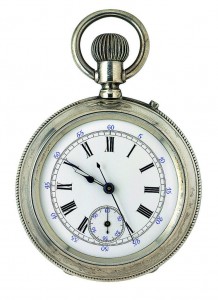
The stated goal of Heuer founder Edouard Heuer was to make chronographs technically simpler and noticeably cheaper without affecting their reliability or precision. In the 19th century, the horizontal clutch was a standard chronograph feature, but Heuer wanted a simpler way to connect the chronograph to the movement. On May 3, 1887, he was granted a patent for what he called an “oscillating pinion,” also known as a “rocking pinion.” It was an arbor with a pinion at each end. One pinion meshed with the movement’s seconds wheel and the other, when the chronograph was switched on, with the chronograph wheel. When the chronograph was switched off, the pinion pulled away from the chronograph wheel. The device worked so well it became a watch-industry staple, and is today used in chronograph movements including the ETA 7750.
2. Mikrograph (1916)
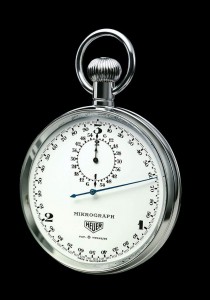
In 1914, Charles-Auguste Heuer set in motion his company’s most ambitious project to date. He asked his watchmakers to create stopwatches that were 10 times more precise than any others. It took them just a few months to come up with fully functioning prototypes, equipped with balances that oscillated at 360,000 vph and were therefore able to measure time to the 1/100-second. Each of these round, rather Spartan-looking pocketwatches had a large crown that doubled as a chronograph push-piece. The chronograph hand rotated at an unusually speedy pace: once every 3 seconds. There was a counter for two elapsed minutes on the upper portion of the dial. The movement was equipped with an antimagnetic lever escapement and a compensating balance with a Breguet balance spring. Heuer was granted a patent for his chronograph mechanism on Oct. 2, 1916. The Mikrograph sold for 100 Swiss francs, or $120. Its accompanying brochure declared, “Notwithstanding its low price, this is the most accurate measurer of ultra-short intervals.”
3. Carrera 12 (1963)
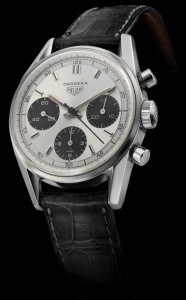
Heuer CEO Jack Heuer, great-grandson of Heuer founder Edouard Heuer, named this tag heuer replica watches ebay after the hair-raising, 2,000-plus-mile Carrera Panamericana car rally held in Mexico from 1950 to 1954. (The race was discontinued in part because it was so dangerous; it was re-instituted in 1988.) It was the very first model in what has become the brand’s flagship collection. The watch was most notable for its dial design. The dial’s flange ascended at a 45-degree angle from the dial’s periphery. Most flanges in those days were blank, but Heuer decided to move the elapsed-seconds scale from the dial to the flange. This made it possible to add nearly 2 mm to the dial’s diameter, hence improving legibility. Heuer gave a 3-D look to the dial by recessing the subdials. He also omitted additional scales such as a telemeter or tachymeter so that the watch would have a pure, tidy look. The watch was powered by the manually wound Valjoux 72 caliber.
4. Monaco (1969)
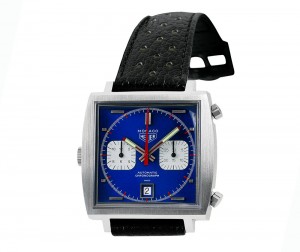
In 1969, the first quartz movements had been developed and were about to hit the market. But no one had yet begun to worry about an impending crisis for mechanical watches, so the world still seemed very much in order for Heuer CEO Jack Heuer. Sales of conventional, manually wound wristwatch chronographs, however, were stagnating, so in 1965 Heuer joined forces with Breitling, Büren and Dubois Dépraz to develop an automatic chronograph movement. It was called Caliber 11 and it went into serial production in 1969. It was one of three automatic chronograph movements unveiled that year, the first such movements ever made. (The others were from Zenith-Movado and Seiko.) Heuer contributed 500,000 Swiss francs to the development of Caliber 11. Heuer cased the movement in an unconventional square yet nonetheless watertight stainless-steel case. Jack Heuer, a car-racing fan, named the replica tag heuer monaco the Monaco, after the Monaco Grand Prix Formula 1 race. There wasn’t much money for advertising, so the company looked for lower-cost ways to promote the watch. Heuer chose the Swiss Formula One driver Jo Siffert as its celebrity endorser. (Siffert was killed in a racing crash in 1971.) Steve McQueen wore Jo Siffert’s original coveralls, along with a Monaco watch, when he starred in the movie Le Mans in 1971. Today, the Monaco is a collectors’ item.
5. Chronosplit Manhattan GMT (1977)
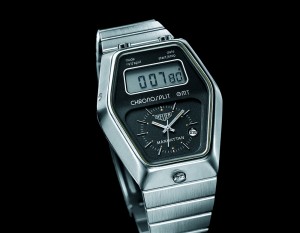
Digital time displays aren’t everyone’s cup of tea. People with weak eyesight, especially, can find it difficult to read their sometimes small numerals. An analog display, which uses hands to indicate the time, is easier to read, some people find. The Chronosplit Manhattan GMT, which debuted in 1977, let its wearers have their time both ways: analog and digital. Heuer described this model as a “timepiece for people who want more than a conventional electronic watch.” The case, made of steel, surrounded a six-sided dial on which the lower half hosted hands to show the hours, minutes and seconds. The date appeared in a little window at 4 o’clock. The movement worked wholly independently of the liquid crystal display, which was positioned in the upper portion of the dial. Buttons to adjust the various functions were located along the upper edge of the case. Even if the chronograph was running, the user could switch the display so it showed 24-hour reference time e.g., the time in the user’s home time zone. (This was the source of the “GMT” in the watch’s name.) The date and the day of the week can likewise be made to appear on the digital display.
6. Mikrotimer Flying 1000 (2011)
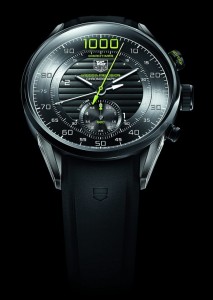
Seeking to buttress its position as the leader in ultra-precise mechanical chronographs, TAG Heuer launched a concept watch, the Mikrotimer Flying 1000, at Baselworld 2011. It did what no previous mechanical timepiece could do: measure intervals to the nearest 1/1,000-second. Like the 1/100-second Mikrograph, this model had two separate power trains, each with its own oscillating and escapement system. The frequency of the chronograph oscillator was an amazing 3.6 million vph (500 Hz). It incorporated a very short, wide and strong balance spring that it developed in collaboration with Atokalpa, the component manufacturer owned by the Sandoz Family Foundation (which also owns Parmigiani Fleurier). This spring works in tandem with a specially conceived lever escapement. The balance spring’s vibrations are started and stopped with the aid of a column-wheel-controlled impulse-and-braking system, which acts directly on the balance spring’s staff. (The watch did not have a balance wheel.) The center-mounted elapsed-seconds hand sprinted around the dial 10 times per second. To read elapsed time to the 1/1,000-second, you had to add the 1/100 and 1/1,000-second quantities, shown on two scales by the long, green center-mounted chronograph seconds hand, to the 1/10-second measurement shown on the subdial (the hand in this subdial rotated once every 5 seconds). The chronograph had a power reserve of just 3.5 minutes. The time-of-day function worked in the conventional manner, using an oscillator with a frequency of 28,800 vph.
7. Carrera Heuer 02 Tourbillon Chronograph (2016)
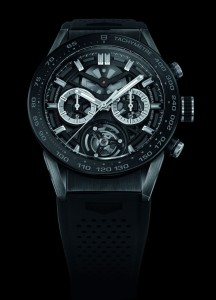
The movement of this watch was derived from TAG Heuer’s in-house chronograph movement, Caliber CH-80, which TAG Heuer launched in 2014. (The company suspended production of the CH-80 almost as soon as the movement was introduced, explaining that it wanted to focus instead on its 1887 chronograph movement.) The watch has a flying tourbillon, 32 mm in diameter and made of titanium and carbon. The movement, which has a single barrel and is COSC-certified, has a power reserve of about 65 hours. TAG Heuer makes the main movement components itself and assembles the movement at its factory in Chevenez. (The balance spring is made by Atokalpa.) The case, like that of the Carrera Heuer 01, is modular and has 12 parts (see previous milestone). But the most noteworthy feature of the watch is neither its movement nor its case but its price: $15,950, amazingly low for a Swiss-made tourbillon, and consistent with the company’s new emphasis on affordability (see above). A limited edition, all-black version is $21,200. For more detail on the watch, click here.